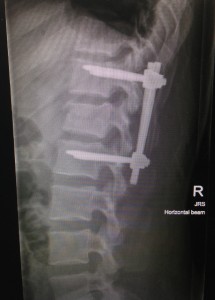 Car accidents, falls and sports injuries are examples of trauma that can cause spine fractures.
Car accidents, falls and sports injuries are examples of trauma that can cause spine fractures.
Spine fractures caused by trauma — such as a sudden blow or injury to the vertebrae — can occur anywhere on the spine, including bones in the neck or cervical spine, bones in the upper back or thoracic spine, the lower back or lumbar spine, and the section of connected bone at the very bottom of the spinal column called the sacrum.
The first symptom of a broken bone is usually pain unless the spinal cord has been injured, which can produce weakness, paralysis and lack of sensation.
Depending on the location of the fracture, the damaged structures can injure the spinal cord or spinal nerves nerves that lead to pain in the arms or legs, or affect the bowel, bladder or sexual organs.
Diagnosis
Dr Sowman will conduct a physical examination asking you about where you feel pain, loss of sensation or difficulty moving.
An xray will show most broken vertebrae but other imaging technology may be necessary to show hard-to-see fractures.
These may include CT and MRI scans
Further X-rays where you are asked to bend your spine forward and backward (dynamic or flexion-extension views).
About 5 percent of spinal injuries have a second fracture either adjacent to the main fracture or elsewhere on the spine. You may be asked to restrict activity or wear a brace until additional studies can be obtained.
Treatment
Treatment of spinal fractures is aimed at realigning the broken pieces and keeping them in alignment until the bone has healed. Healthy broken bones will naturally form more bone tissue around the broken edges to “knit” the broken edges. Specific treatment of traumatic spine fractures depends on the location of the fracture, its severity and how it impacts nearby tissue and nerves.
Some fractures heal well with external bracing. Cervical fractures can sometimes be treated with a halo vest (a ring attached to the skull and attached to a vest on the chest). Other fractures may require surgical stabilization, with implanted screws, hooks and connecting rods, and fusing that portion of the same spine (placing bone graft to help the bones grow together). There are some fractures which my need to be observed to determine whether bone will heal on their own or if surgery will be needed. Surgery is recommended for many patients who suffer neurologic injury at the time of their fracture to remove any bone or disc material that is still compressing the neural structures, and to stabilize that part of the spine to minimize additional trauma to that region.

